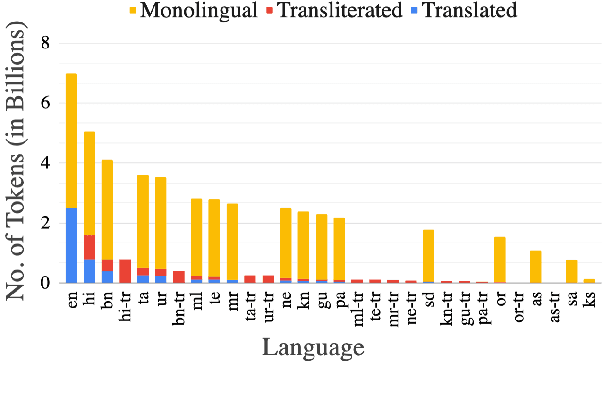Sarvesh Mehtani
Exploiting Language Relatedness for Low Web-Resource Language Model Adaptation: An Indic Languages Study
Jun 09, 2021



Abstract:Recent research in multilingual language models (LM) has demonstrated their ability to effectively handle multiple languages in a single model. This holds promise for low web-resource languages (LRL) as multilingual models can enable transfer of supervision from high resource languages to LRLs. However, incorporating a new language in an LM still remains a challenge, particularly for languages with limited corpora and in unseen scripts. In this paper we argue that relatedness among languages in a language family may be exploited to overcome some of the corpora limitations of LRLs, and propose RelateLM. We focus on Indian languages, and exploit relatedness along two dimensions: (1) script (since many Indic scripts originated from the Brahmic script), and (2) sentence structure. RelateLM uses transliteration to convert the unseen script of limited LRL text into the script of a Related Prominent Language (RPL) (Hindi in our case). While exploiting similar sentence structures, RelateLM utilizes readily available bilingual dictionaries to pseudo translate RPL text into LRL corpora. Experiments on multiple real-world benchmark datasets provide validation to our hypothesis that using a related language as pivot, along with transliteration and pseudo translation based data augmentation, can be an effective way to adapt LMs for LRLs, rather than direct training or pivoting through English.
MuRIL: Multilingual Representations for Indian Languages
Apr 02, 2021



Abstract:India is a multilingual society with 1369 rationalized languages and dialects being spoken across the country (INDIA, 2011). Of these, the 22 scheduled languages have a staggering total of 1.17 billion speakers and 121 languages have more than 10,000 speakers (INDIA, 2011). India also has the second largest (and an ever growing) digital footprint (Statista, 2020). Despite this, today's state-of-the-art multilingual systems perform suboptimally on Indian (IN) languages. This can be explained by the fact that multilingual language models (LMs) are often trained on 100+ languages together, leading to a small representation of IN languages in their vocabulary and training data. Multilingual LMs are substantially less effective in resource-lean scenarios (Wu and Dredze, 2020; Lauscher et al., 2020), as limited data doesn't help capture the various nuances of a language. One also commonly observes IN language text transliterated to Latin or code-mixed with English, especially in informal settings (for example, on social media platforms) (Rijhwani et al., 2017). This phenomenon is not adequately handled by current state-of-the-art multilingual LMs. To address the aforementioned gaps, we propose MuRIL, a multilingual LM specifically built for IN languages. MuRIL is trained on significantly large amounts of IN text corpora only. We explicitly augment monolingual text corpora with both translated and transliterated document pairs, that serve as supervised cross-lingual signals in training. MuRIL significantly outperforms multilingual BERT (mBERT) on all tasks in the challenging cross-lingual XTREME benchmark (Hu et al., 2020). We also present results on transliterated (native to Latin script) test sets of the chosen datasets and demonstrate the efficacy of MuRIL in handling transliterated data.
 Add to Chrome
Add to Chrome Add to Firefox
Add to Firefox Add to Edge
Add to Edge